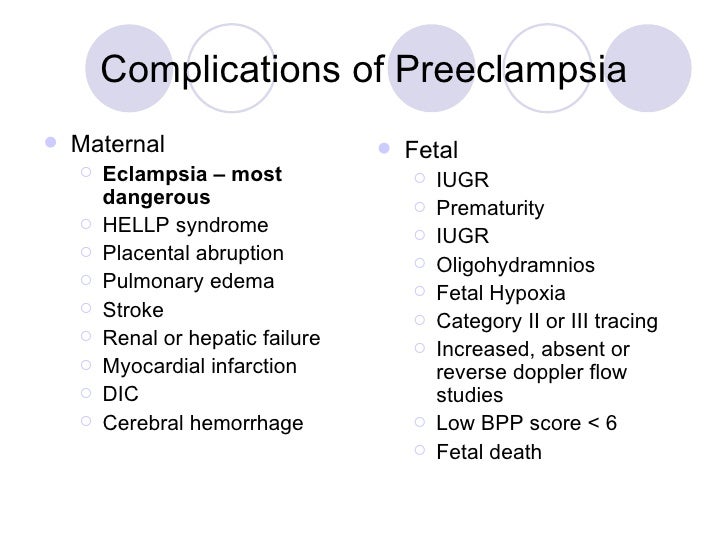Eclampsia
Eclampsia
Eclampsia is a disorder of pregnancy characterized by seizures in the setting of pre-eclampsia. Typically, the pregnant woman develops Hypertension and Proteinuria before the onset of a convulsion.
It is the progression of a more severe form of pre-eclampsia in which convulsions occur. It is an obstetrical emergency having incidence of 1 in 68 to 500 deliveries.
Etiology
The cause remains unknown but proposed factors are:
- Eclampsia is usually preceded by headache, hyper-reflexes, visual disturbances and epigastric pain.
- Hypertensive Encephalopathy.
- Vasospasm, haemorrhage, ischemia and oedema of cerebral hemisphere.
- A seizure or convulsion results when there is an excessive synchronous electrical discharge of neurons within the central nervous system.
| System | Changes |
| Cardiovascular |
|
| Hematologic |
|
| Renal |
|
| Hepatic |
|
| Central nervous system |
|
Clinical Features
- Primigravida is more prone than multigravida.
- Timings of onset can be antepartum, the labour usually starts and is of serious type, intrapartum and postpartum within 48 hours and its incidence is less.
- The onset is sudden and the seizure begins with the stage of invasion-lasting few seconds, during this stage woman’s eye roll to one side and twitching of muscles ensues. Second is stage of contraction and lasts for 15-20 seconds and is characterized by generalized tonic muscular contraction, the face distorted, eyes protrude and the arms are flexed and the hands are clenched. Thirdly the stage of seizure occur which lasts for a minute. In this suddenly the eyelids begin to open and close violently. All the muscles of the body alternatively contract and relax forcefully in rapid succession. Blood tinged foam exudes from the mouth. It may last a minute. Then the client may be semi-comatose or comatose. This may last for a few minutes to few hours. Consciousness is regained or this may be followed by another seizure.
Symptom of post-partum Eclampsia
- Seizures
- Coma
- Headache
- Fatigue
- Changes in Vision
- Double vision
- Aching muscles
- Increase blood pressure
- Increase protein in urine (Proteinuria)
- Generalised oedema
- Reduced urination
- Abnormal liver function and kidney function
- Right upper quadrant pain or epigastric pain
- Hyperactive reflexes
Complication of Eclampsia-
Eclampsia patient are at risk for several complication, and as such preventive and careful monitoring are essential.
- Cardiovascular- Vasospasm, Pulmonary oedema
- Renal- Ischaemia, Oliguria, Renal Failure
- Haematological- Hypovolemia, Thrombocytopenia, Haemorrhage, Disseminated intravascular coagulation
- Neurological- Cerebral oedema, Cerebral haemorrhage.
- Hepatic- Hepatocellular damage, Hepatic rupture.
- Foetal- Placental abruption, Foetal distress, Intrauterine death

Nursing Interventions
- Assess for signs of impending Eclampsia-
- Hyperactivity of deep tendon reflexes (3+to 4+)
- Ankle clonus
- Decrease pulse and respiration
- Epigastric pain
- Oliguria(<50ml/hour)
- The immediate care during a convulsion is to ensure a patent airway and oxygenation.
- The woman is turned to her side to prevent aspiration of vomitus.
- After the convulsion ceases the suction is done.
- Time, duration and description of convulsion is recorded.
- It is essential to provide comprehensive and regular prenatal care and proper treatment of pregnancy induced hypertension.
- Protect the patient from self-injury. The patient is not left alone, side rails be padded. Padded tongue blades to be inserted between the jaws at the onset of seizure.
- Protect the eclamptic woman from extraneous stimuli like bright lights and noise.
- Foot of the bed may be raised a few inches to facilitate drainage of secretions from the respiratory tract.
- An indwelling catheter is required.
- For maintaining fluid and nutrition intravenous infusion of glucose saline and ringer’s solution is given as per direction.
- Assistance with hygiene required.
- Medications like anticonvulsants — Inj. Largactil, 50 mg., Inj. Phenergan 25 mg or diazepam 30 mg. intravenous and antihypertensive drugs like Serpasil 2 mg, Inj. Lasix 20 mg intramuscular is given as per direction.
- Vital signs, oedema, height of fundus, presentation and position of foetus, foetal heart should is noted and urine is tested for proteins.
- Assessment of uterine activity, cervical status, foetal status is performed. The membranes may rupture and birth may be imminent.
- The obstetrical management — the woman usually comes to labour while she is having convulsions. If labour doesn’t start it is initiated immediately by low rupture of membranes or caesarean section is done. If the baby dies in uterus spontaneously labour is awaited.
- Complications like pulmonary oedema, renal failure disseminated intravascular coagulation cerebral haemorrhage, intrauterine foetal death. During postpartum period Antihypertensive regimen, be continued.
- Follow-up is essential, client may develop hypertensive disease is subsequent pregnancy.
important points
- According to gestational age pre-eclampsia may be-
- Early <34 weeks
- Late >34 weeks.
- Mangement of eclampsia and severe pre-eclampsia includes -
- Control of fits
- Control of typertension Drug used for control of fits is magnesium sulfate (IM/IV regimens).
- First-line antihypertensives are: a- Labetalol, b- Hydrazine c- Nifedipine. Target levels of BP to control is SBP = 140-160 mm Hg and DBP = 90-100 mm Hg
- Termination of pregnancy (delivery) is the only definitive treatment for pre-eclampsia.
- Convulsions in eclampsia has got four stages-
- Premonitory stage,
- Tonic stage,
- Clonic stage
- stage of Coma.
- MgSO4, is the drug of choice in the management of eclampsia to control convulsion. It is cominued for 24 hours after the last seizure or delivery whichever is later.
- Repeat doses of MgSO4, are given only if the knee jerks are present urine output exceeds >30 ml/hour and the respiration rate is>12/min